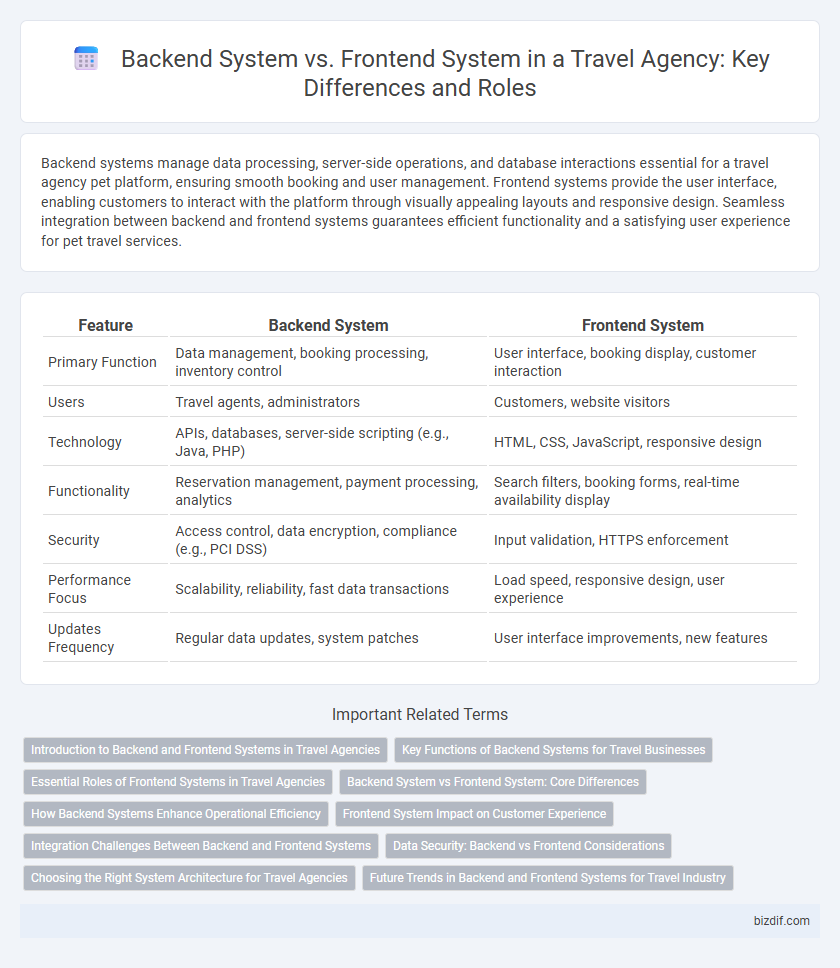Backend systems manage data processing, server-side operations, and database interactions essential for a travel agency pet platform, ensuring smooth booking and user management. Frontend systems provide the user interface, enabling customers to interact with the platform through visually appealing layouts and responsive design. Seamless integration between backend and frontend systems guarantees efficient functionality and a satisfying user experience for pet travel services.
Table of Comparison
| Feature | Backend System | Frontend System |
|---|---|---|
| Primary Function | Data management, booking processing, inventory control | User interface, booking display, customer interaction |
| Users | Travel agents, administrators | Customers, website visitors |
| Technology | APIs, databases, server-side scripting (e.g., Java, PHP) | HTML, CSS, JavaScript, responsive design |
| Functionality | Reservation management, payment processing, analytics | Search filters, booking forms, real-time availability display |
| Security | Access control, data encryption, compliance (e.g., PCI DSS) | Input validation, HTTPS enforcement |
| Performance Focus | Scalability, reliability, fast data transactions | Load speed, responsive design, user experience |
| Updates Frequency | Regular data updates, system patches | User interface improvements, new features |
Introduction to Backend and Frontend Systems in Travel Agencies
Backend systems in travel agencies manage critical functions such as booking databases, payment processing, and inventory management, ensuring seamless transaction flow and data integrity. Frontend systems provide user interfaces for customers and agents to search flights, hotels, and packages, offering real-time availability and booking options. Integrating these systems optimizes customer experience and operational efficiency by synchronizing data between user requests and backend processing.
Key Functions of Backend Systems for Travel Businesses
Backend systems for travel businesses handle key functions such as booking management, inventory control, and payment processing to ensure seamless operations. These systems integrate with global distribution systems (GDS) like Amadeus, Sabre, and Travelport to access real-time flight, hotel, and car rental data. Robust backend architecture also supports customer data management, reporting analytics, and API connectivity to enhance service delivery and operational efficiency.
Essential Roles of Frontend Systems in Travel Agencies
Frontend systems in travel agencies play a crucial role in delivering seamless user experiences by providing intuitive interfaces for customers to search, book, and manage travel plans efficiently. These systems handle real-time interaction with travelers, offering personalized recommendations, secure payment processing, and responsive design across devices. Their optimization ensures faster load times, enhanced usability, and integration with backend databases that manage inventory and pricing.
Backend System vs Frontend System: Core Differences
Backend systems in a travel agency manage server-side operations such as database management, booking processing, and API integrations to ensure seamless data flow and secure transactions. Frontend systems focus on user interface design, enabling customers to search flights, view itineraries, and make reservations with intuitive navigation and responsive layouts. The core difference lies in backend systems handling data logic and infrastructure, while frontend systems prioritize user experience and visual interaction.
How Backend Systems Enhance Operational Efficiency
Backend systems in travel agencies streamline booking management, inventory control, and real-time data synchronization, reducing manual errors and accelerating transaction processing. These systems integrate with global distribution systems (GDS) and payment gateways, enabling seamless updates and secure financial operations. Enhanced automation and centralized data storage improve staff productivity, customer service response times, and overall operational efficiency.
Frontend System Impact on Customer Experience
Frontend systems in travel agencies serve as the primary interface through which customers interact with booking platforms, offering intuitive navigation and real-time search results that enhance decision-making and satisfaction. Responsive design and personalized content delivery significantly improve user engagement and trust, driving higher conversion rates and repeat bookings. Efficient frontend systems also streamline transactions and provide instant support features, minimizing user frustration and elevating the overall customer experience.
Integration Challenges Between Backend and Frontend Systems
Integration challenges between backend and frontend systems in travel agencies often arise from inconsistent data formats and API incompatibilities, leading to delayed booking confirmations and inaccurate itinerary updates. Ensuring real-time synchronization between backend databases managing hotel availability, flight schedules, and payment gateways with frontend user interfaces requires robust middleware solutions. Latency issues and security vulnerabilities during data exchange further complicate seamless integration, impacting user experience and operational efficiency.
Data Security: Backend vs Frontend Considerations
Backend systems in travel agencies handle sensitive customer data, such as payment details and personal identification, requiring robust encryption and access controls to prevent breaches. Frontend systems must focus on secure user authentication, session management, and data validation to protect against unauthorized access and injection attacks. Ensuring seamless interaction between backend and frontend security protocols enhances overall data protection and regulatory compliance, like GDPR and PCI DSS.
Choosing the Right System Architecture for Travel Agencies
Choosing the right system architecture for travel agencies involves evaluating backend systems, which manage databases, booking engines, and payment processing, against frontend systems that deliver user interfaces and customer interactions. A robust backend architecture ensures seamless integration with global distribution systems (GDS) and real-time inventory updates, while an intuitive frontend enhances user experience through responsive design and personalized content. Optimizing both systems guarantees efficient operations, scalability, and improved customer satisfaction in the competitive travel industry.
Future Trends in Backend and Frontend Systems for Travel Industry
Future trends in backend systems for the travel industry emphasize cloud-native architectures, microservices, and AI-driven data analytics to enhance scalability and personalized service delivery. Frontend systems are evolving toward immersive user experiences through augmented reality (AR), voice-activated interfaces, and seamless omnichannel integration to improve customer engagement. Both backend and frontend advancements prioritize real-time data processing, robust cybersecurity measures, and adaptive AI algorithms to meet the dynamic demands of travelers and optimize operational efficiency.
Backend System vs Frontend System Infographic

 bizdif.com
bizdif.com